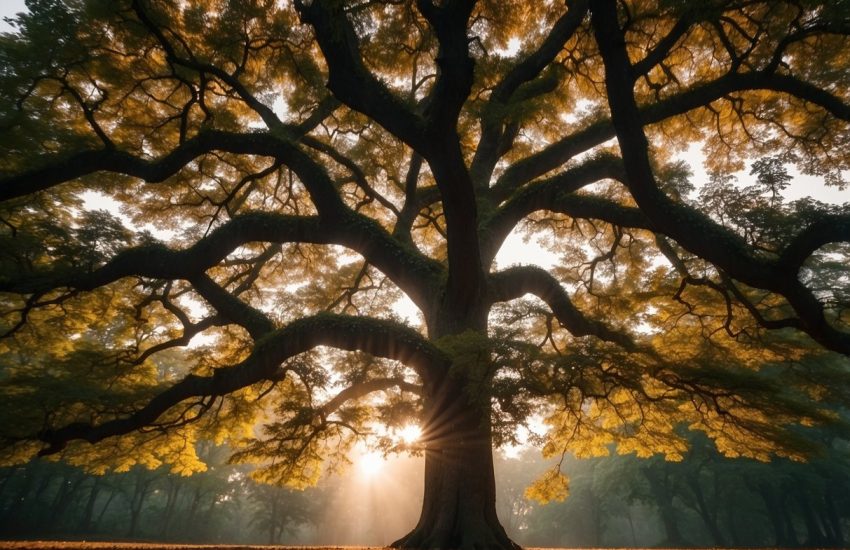Types of Oak Trees in South Carolina: A Comprehensive Guide
South Carolina is home to a diverse range of flora and fauna, including a variety of oak trees. Oak trees are an important component of the state’s ecosystem and culture, providing food and shelter for numerous species of birds and mammals, as well as serving as a symbol of strength and longevity in human culture.

There are several types of oak trees that can be found in South Carolina, each with its own unique characteristics and adaptations. Some of the most common types include the Southern red oak, the white oak, and the blackjack oak. The Southern red oak is known for its vibrant fall foliage and its ability to thrive in a variety of soil types, while the white oak is prized for its strong, durable wood and its ability to support a variety of wildlife. The blackjack oak, on the other hand, is known for its hardiness and its ability to withstand drought and other adverse conditions.
Whether you’re a nature enthusiast, a wildlife observer, or simply someone who appreciates the beauty of the natural world, learning about the different types of oak trees in South Carolina can be a fascinating and enriching experience. By understanding the unique characteristics of each species, you can gain a deeper appreciation for the vital role that these trees play in the state’s ecosystem and culture.
Common Oak Species in South Carolina
South Carolina is home to several oak species, each with its unique characteristics and uses. In this section, we will discuss the most common oak species found in South Carolina.
Live Oak
The Live Oak tree, scientifically known as Quercus virginiana, is an evergreen tree that is native to the southeastern United States, including South Carolina. It is a popular tree for landscaping due to its attractive appearance and resistance to storms and salt spray. The Southern Live Oak, a variety of the Live Oak tree, is the state tree of Georgia and is commonly found in South Carolina.
Live Oak trees have dark green, leathery leaves that are oval-shaped and stay on the tree year-round. They produce acorns that are an essential food source for wildlife, such as deer and squirrels. The wood of the Live Oak tree is dense and hard, making it suitable for furniture and flooring.
White Oak
The White Oak tree, also known as Quercus alba, is a deciduous tree that is native to eastern North America, including South Carolina. It is a slow-growing tree that can live for several hundred years. The White Oak tree is highly valued for its wood, which is used in furniture, flooring, and barrels for aging wine and whiskey.
White Oak trees have lobed leaves that turn reddish-brown in the fall. They produce acorns that are a food source for wildlife, such as deer, turkey, and squirrels.
Red Oak
The Red Oak tree, scientifically known as Quercus falcata, is a deciduous tree that is native to the eastern United States, including South Carolina. It is a fast-growing tree that can reach heights of up to 100 feet. The wood of the Red Oak tree is commonly used in furniture, flooring, and construction.
Red Oak trees have leaves that are deeply lobed and turn red in the fall. They produce acorns that are a food source for wildlife, such as deer and squirrels.
Other Notable Oaks
In addition to the Live Oak, White Oak, and Red Oak trees, South Carolina is also home to several other notable oak species, including the Willow Oak, Black Oak, Chestnut Oak, and Swamp Chestnut Oak. Each of these oak species has its unique characteristics and uses, making them valuable additions to the South Carolina landscape.
Overall, South Carolina’s oak trees are an essential part of the state’s natural beauty and ecosystem. They provide food and shelter for wildlife, valuable wood for construction and furniture, and add to the aesthetic appeal of the state’s natural landscape.
Ecology and Care of Oak Trees

Habitats and Soil Types
Oak trees are highly adaptable and can grow in a variety of habitats and soil types. They are commonly found in upland areas and coastal plains of South Carolina. Oak trees prefer well-drained soils with a pH between 5.0 and 6.5. They can tolerate drought conditions but require regular watering during prolonged dry spells.
Threats and Diseases
Oak trees are susceptible to various pests and diseases, including oak wilt and bacterial leaf scorch. These diseases can cause significant damage and even death to the tree. Pruning and professional tree care can help prevent the spread of these diseases. It is important to monitor oak trees for signs of pests and diseases and take appropriate action if necessary.
Conservation and Landscaping
Oak trees play an important role in the ecosystem and provide habitat for wildlife. They also serve as shade trees and can be used as landmark trees in landscaping. When planting oak trees, it is important to consider the climate and soil conditions of the area. Proper watering and fertilization can help ensure healthy growth and longevity of the tree.
In conclusion, understanding the ecology and care of oak trees is essential for their conservation and longevity. By taking appropriate measures to prevent pests and diseases, and providing proper care and maintenance, oak trees can thrive in various habitats and soil types.


